Serendip is an independent site partnering with faculty at multiple colleges and universities around the world. Happy exploring!
Play in the City 2013

|
|
Welcome to the on-line conversation for Play in the City, an Emily Balch Seminar offered in Fall 2013 @ Bryn Mawr College, in which we are addressing the question of how we construct, experience, and learn in the act of play. How is play both structured by the environment in which it occurs, and how might it re-structure that space, unsettling and re-drawing the frame in which it is performed? This is an interestingly different kind of place for writing, and may take some getting used to. The first thing to keep in mind is that it's not a site for "formal writing" or "finished thoughts." It's a place for thoughts-in-progress, for what you're thinking (whether you know it or not) on your way to what you think next. Imagine that you're just talking to some people you've met. This is a "conversation" place, a place to find out what you're thinking yourself, and what other people are thinking. The idea here is that your "thoughts in progress" can help others with their thinking, and theirs can help you with yours. |
Who are you writing for? Primarily for yourself, and for others in our course. But also for the world. This is a "public" forum, so people anywhere on the web might look in. You're writing for yourself, for others in the class, AND for others you might or might not know. So, your thoughts in progress can contribute to the thoughts in progress of LOTS of people. The web is giving increasing reality to the idea that there can actually evolve a world community, and you're part of helping to bring that about. We're glad to have you along, and hope you come to both enjoy and value our shared explorations. Feel free to comment on any post below, or to POST YOUR THOUGHTS HERE.

Slow Down

The lady in the photo slowly put down her cigarette, and looked at it. The lady in front of her was looking at her, probably waiting for her words. But she just sat there in silence. She didn’t speak a word until we left. Under the warm street lights, people were lingering slowly, slowly enough to make ten meters a long distance. So were we. We walked slowly with the crowd. Everything and everyone around us just slowed us down.
Chengdu is famous for its slow life pace. 256 B.C., Li Bing and his son built Dujiangyan, a hydraulic project which makes Chengdu a place without floods or droughts. When everything was very dependent on agriculture, this project greatly benefitted Chengdu, and made Chengdu a wealthy place. People never worried about their life in that period of time, and they spent more time seeking for a more comfortable lifestyle. There is an old saying: “Never go to Chengdu when you are young.” Because you will lose your ambitions, and will just indulge yourself in comforts at a young age. Today, there are people in the park who just sip tea for a whole afternoon. I asked my dad, “What is the meaning of sitting there and drinking tea for hours?” My dad said, “The meaning is that there is no meaning of it.”

The City
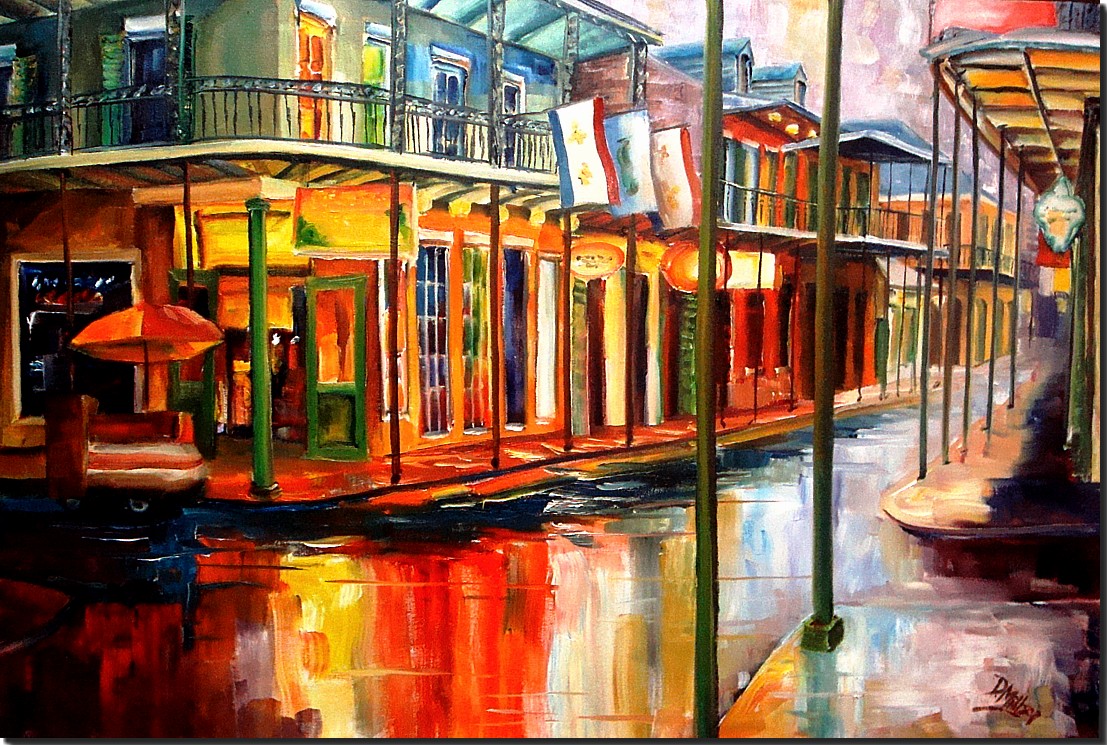
(“Downpour on Bourbon Street” by Diane Millsap)
Whether one considers New Orleans or New York City, some concepts a City hold true. The city is huge and vast and crowded, nothing quite so much as a humongous hidden object game, rivers of nameless faces in nameless places going about their unknown businesses. Here and there are bright faces and familiar places from fond memories or exciting opportunities. A museum, a zoo, a bakery, a mahjong game-- the city is a sugar rush. Tasty and often ending in an energy crash, which never forestalls the next rush. The city is amazing for its opportunities, adventures, the stories lucking on every street corner and every stranger’s eye. The city is exhausting- constant lights, sights, sounds, the unending press of people. Even the exhaustion can be exhilarating; there is nothing quite like when the city starts to sing, when the car horns and twinkling lights make up an impromptu extravaganza. Although cities are often draining, they are fun and terrific places to spend time go on adventures.

The City Does Sleep
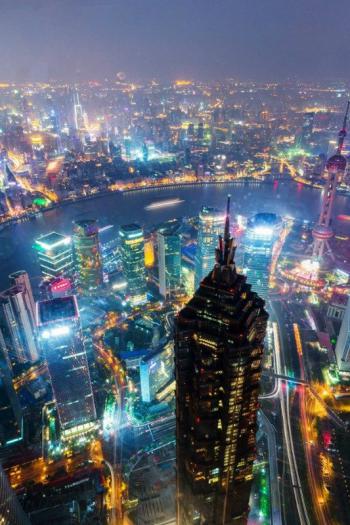 (Photos from Chinese social network)
(Photos from Chinese social network)
I was born and raised in Hangzhou, China, and I went living in Shanghai two years ago. I felt suffocated at first. Not that I was nervous about living in a metropolis, since Hangzhou was also a big city, but much cleaner and quieter than Shanghai. During the first week in Shanghai, I was claustrophobic of so many buildings, scared at how bare the streets looked without trees, and nearly car-crashed for several times because drivers never seemed to be aware of pedestrains' existence. And walking in the city that never sleeps, every neon-light was like a bullet to me, ruthlessly litting every inch of space around me, leaving nowhere to hide.

Small and Large: American and European Cities
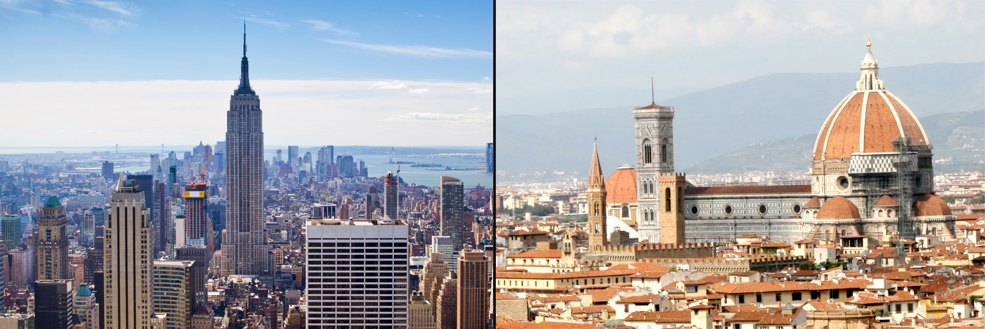
I’m a traveler, born ready to explore every city in the world. I’ve been to many countries over the years, visiting many cities. And I’ve noticed that the cities in America are very different from the cities in other places I’ve visited. America is made up of people from different cultures. When people immigrated to America, they came to the cities. I can’t go ten feet in New York without hearing someone speak in a different language, or see a small mom-and-pop diner that guarantees food straight from one homeland or another. At the same time, everywhere I look in Silicon Valley there’s an Indian woman walking in her sari or an Asian mom speaking rapidly to her children in Korean before dropping them off at school. In America, the cities are inherently diverse communities, in terms of nationality as well as culture, values, and language.
The cities in Europe, however, are very different. They were created in a different time, when people mostly stayed where they were born. The people in many European cities are very similar: they look the same, dress the same, speak the same language. They don’t have the same obvious diversity that can be found in American cities. But that doesn’t mean that they aren’t cities. It’s simply a different experience.

Nanjing,The City of Glaring History and Culture
 Yijing Lu
Yijing Lu
Nanjing is a wonderland where my hometown located. I am, actually, extremely proud to introduce this city as my birthplace, because this beautiful city absorbs me deeply due to the fact that Nanjing is not only covered with atmosphere of long history and flourishing culture, but also full of scenic spots and historical sites where I visited for several times with my parents and friends when I was young. To be honest, I am a girl who loves to research Chinese culture and traditions. Thus, in this paper, I am willing to introduce this city from the perspective of history and culture, and, of course, the relationship to me.
Under the Edification of History
Nanjing is a historic city which was chosen as the capital of China in ten more dynasties during the whole Chinese history. (details are showed in the following form)
Due to the fact that Nanjing is carrying massive history, several main streets and roads in Nanjing are named after the Used Name of the City as a kind of commemoration of the long history, such as Jian Ye Road, Jian Kang Road, and so on. Every time when I walk on those roads, I think about the stories and the heroes of those dynasties, and feel that all the sceneries of the roads around me are covered with historical mystery.

A Place of Wonder
For me cities are a place of friendship, excitement, and adventure. By not growing up in a city, I believe my relationship to cities is much different than those who would consider a city their home. Although I live relatively close to the metropolis of San Francisco, I would never consider it as the place where I am from, but rather as the place I would visit to explore. My fondest memories of San Francisco are not of the Golden Gate Bridge, or of Lombard Street, but of my best friends apartment.
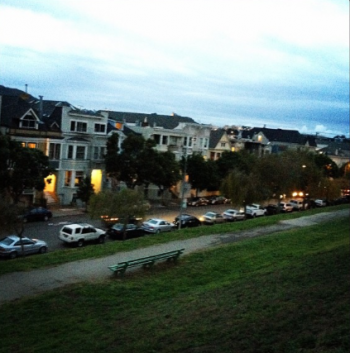 Located on the corner of a park and across from a restaurant, this quaint little apartment filled up quite a few of my summer nights between the ages of nine and twelve. This little piece of San Francisco belonged to the family of my best friend Mathilda for four years as a second apartment while her stepfather was working in the city. We would take trips up to the city for weeks at a time to explore the art museums, enjoy theater performances, marvel at animals within the San Francisco Zoo, and experience the city for what it was, and what it had to offer.
Located on the corner of a park and across from a restaurant, this quaint little apartment filled up quite a few of my summer nights between the ages of nine and twelve. This little piece of San Francisco belonged to the family of my best friend Mathilda for four years as a second apartment while her stepfather was working in the city. We would take trips up to the city for weeks at a time to explore the art museums, enjoy theater performances, marvel at animals within the San Francisco Zoo, and experience the city for what it was, and what it had to offer.

Indecision
I don't have a photograph.
I mean, I could have one if I wanted, but I am terrible at making decisions. I couldn't possibly choose one photo from one city, from one home, from one chapter in my life and use it to illustrate how it shapes me and my mentality.
It is precisely my indecision that depicts the impact my life has had on my mentality. I don't want to have to choose, and deny all the other pieces of myself.
Richmond, Virginia
I'm seven years old. I go to a public school in the Fan district. My best friend, Grace, and I like to do silly things around the neighbourhood. Because we have no reason not to. We pick flowers that grow in the cement cracks in the alleyways. We crush the petals and mix them with her mother's expensive perfume, some lemon juice, a bit of white, silky hair conditioner, and other things that smell nice. Then we pour and distribute the ambiguously-aromatic concoction into ten red, plastic cups and place them neatly on a tray.
Our plan is to go from door to door around the block and sell as many of our perfume cups as we can. Prices are flexible, we decide beforehand. When a woman answers the door, we use our amateur entrepreneurial talents to convince her that smelling beautiful is being beautiful and we are just the two people who can make that happen for her. When a man answers the door, we improvise and explain the perfume cups also function as air fresheners and would make even the most odorous of rooms smell divine beyond belief, as is very likely the case.

City and Adventure

This picture was taken inside Atlas Eats Kitchen and Bake Shop. The shop is cozy, internationally themed, and has a cheap breakfast. It is located in a residential area, where you would not expect to find a restaurant. When I first went to the shop I wasn’t expecting anything special because of its peculiar location. I ended up being surprised by how unique and delicious it was. Since then it has become one of my favorite places to eat.
For me the city is a place of potential beauty through risk. By taking risks with my time and money to try something new, I am going on an adventure. In this adventure I may meet new people, try new food, and see new things. I will also have a unique space to reflect.
The statements, “That was great.” or “That was terrible.” are both more interesting to me than, “It was the usual.” Whether or not I have a positive experience going out, my experiences combine to form a picture of what to expect from the city. The feelings of love, hate, or indifference I associate with the city particularize my connection to that place. This connection forms a relationship between the guts of city and me. The guts are the people, food, sights, sounds, and smells that become my overall feelings towards the city.

The City is Others
I took a picture when I was in Paris the summer of 2012. It was originally meant to capture the metro station, so I would remember how different they seemed from those I knew at home. I happened to also catch a small huddle of people in the picture, though. They are laughing together, waiting for their train. Looking back, this represents everything I feel about cities.
I could say, as I had originally written down in my notes for this essay, that I judge a city based on its public transportation. But this isn’t quite true. Just as I meant to capture a photo of the metro station and ended up with a shot of a group of friends, I really judge a city based on the people in it (and perhaps I see the most of these people on the transport systems, which is why I jumped to that train of thought first).
When I go into a city, I’m mesmerized by all of the people walking around. It’s hard to imagine each of them having their own lives and stories, yet they do. When you see someone laughing, you know they have their own private joke, one you won’t ever be privy to. You can catch so many glimpses into so many lives when you’re in the city. And I thrive in that knowledge. Sometimes it even helps me to feel like I know people, even if I don’t know a single soul there.

I left my heart in San Francisco
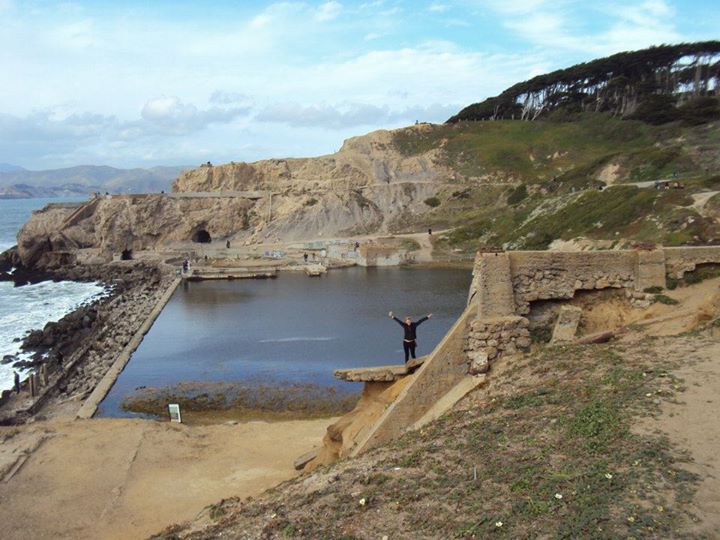
Every time someone at Bryn Mawr asks me where I’m from, I get excited. I alway smile as a sense of pride and gratitude wash over me, but say “I’m from San Francisco,” as if it’s no big deal. It is a big deal, though. I’ve been told countless times that I’ve lived in a bubble my whole life, and I believe it. San Francisco and the whole Bay Area have a vibrant and accepting culture, but unlike a lot of bigger cities, San Francisco tends to be more relaxed and happy. Besides its attractions like the Golden Gate Bridge, it boasts the highest minimum wage in the country, and is one of the leading cities in environmentalism in the U.S. It’s a haven for every type of person imaginable.
Although I didn’t always take advantage of all San Francisco had to offer, there was something exciting about having everything I could want within reach. I took everything the city offered for granted: food trucks with obscure fusion foods; the Haight Ashbury with its thrift stores, hipsters, and hippies; milk tea and boba in The Sunset; people(intoxicated or otherwise) talking about who-knows-what to no one; compost bins and 3 different types of recycling everywhere I went; Taquerias in The Mission; flyers telling me to go vegan; and many more.

Spider-Art
Phoenix
MLord
Play in the City 028
Sunday, September 08, 2013
Spider-Art
The subject of this photograph is a picture titled Spiderman, by Sigmar Polke, which can be found at the Museum of Modern Art (MOMA) in New York, New York. It cannot truly be called a painting, because it is composed of “cut-and-pasted painted papers on canvas” (MOMA). However, I will refer to it as such to more clearly distinguish it from my photograph.
Spiderman’s title character is a seemingly emblematic feature of New York. Like many superheroes, Spider-Man fights evil in a big city, but unlike DC Comics characters Batman and Superman, he baldly claims his city to be one of our own. On the same trip on which I took this photograph, I passed a street performer dressed as the famous webslinger. On another, I watched the Broadway production Spider-Man: Turn Off the Dark. My habit is to buy a T-shirt to commemorate every place I visit, and for my New York memento, I bought one of the shirts available for purchase in the lobby of the theater.

I Want to be Lost
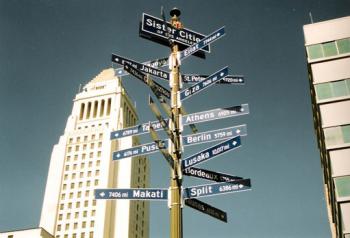
Photo from: http://www.gpsmagazine.com/assets/review-ln740/routing_engine.jpg
To understand what the city means to me you first have to know that I grew up in a very small agricultural town. There are family farms whose land come from grants dating back to when William Penn first settled the area. There are no police or fire departments and the most exciting thing to happen in quite a few years was when Hurricane Irene hit and the bridges were too flooded to cross. My town is small enough that I know my neighbors, have a regular table at a small restaurant every Thursday, and have babysat for one of our Township Supervisors, our equivalent to a mayor. I drive down the roads and I see cows and horses and signs for home farmed eggs and milk. We have one traffic light at the intersection of a veterinary hospital, family-run hardware store, post office and elementary school. My town is the quintessential small town.

Live, laugh and love
This is a part of the photo series Follow me, taken by a Russian photographer Murad Osmann. Travelling around the world with his girlfriend Nataly Zakharova, he documented their trips by taking photos in which Nataly always holds his hand, leading the way. In retrospect, this is just like the relationship between me and the city. I feel like we're holding hands whenever I walk on the streets and alleys of the city. I lead the way, but the city is always behind me, following closely. I've lived, laughed and loved in the city. Here is my home.
"City creates the theater and is the theater", as Lewis Mumford writes in What Is a City. We all live in a city theater. We perform our lives and dramas here. However, this is not just a theater for fictional plays. This is also our real-life stage.

"I feel extrinsic to the city"
Since the number 14 is not easily divisible by 3 (or, actually, at all), and since we wanted to be sure that each of you had @ least 2 readers for her essay, I’ve decided to join one of the writing clusters in my section. And so I thought also—just playing along—that I’d throw a short piece I wrote earlier this summer, as Mark and I were designing this class, into the mix. See "I feel extrinsic to the city" (to make sense of this piece, you might want to start with the post above, poor b.b. (plus), which gives the context: a poem by Bertold Brecht, and then a commentary by Mark (which happens, also, to be the story of his own relationship to the city…)

The City in All of its Seasons
Every trip into the city feels like a new and exciting adventure, even if I do exactly the same thing every time I am there. The favorite destination for my sisters and I is the food carts in the center of town. My sisters always have Pad Thai from their favorite cart and I almost always have a sandwich. Even though we have done this same trip so many times, the thrill of being in the city has never gone away.
Walking around the block full of delicious food carts, I get to see all sorts of people that also call Portland their home. During the lunchtime rush, people from all walks of life gather on the sidewalks surrounding the carts as they eagerly search out their food. I always have to walk around the block two or three times just to figure out what kind of food I want. With so many choices I look in awe at each cart until I settle for my usual, a sandwich. As I spend around fifteen minutes looking around confused, my sisters decide if they’d like to split Pad Thai and figure out how spicy they want it to be.

Ms. Ackerman Goes to Washington

My relation to the City is best summed up by an anecdote: The Time Jacob and I Found the 9:30 Club (pictured above).
I live in Herndon, Virginia, a small town in the shadow of Washington, DC. There are always a lot of events my friends and I think of going to, but never actually do. Then, my best friend Jacob noticed that one of our favorite bands was coming across the pond to play a show at a small but well-known venue in DC, The 9:30 Club, the night before Homecoming of our junior year. Unlike the times with other bands when we would wistfully shrug and say we’d “catch them next time”, Jacob and I actually bought tickets. In the days before the concert, we painstakingly planned what metro stop we’d get on at, where we’d transfer trains, and which street we’d take after we left the station.
The night came, and our carefully planned commute got us to our stop right when we thought it would, so all that was left was for us to actually walk to the club.
The problem was that neither of us had ever been there before.
We turned left out of the station, and then walked up the road until we saw what we thought was the street we were supposed to turn right on. We followed that for a couple blocks until we noticed that the numbers were going in the wrong order.

Concrete and Metal

If I knew one thing for certain at that point in my life, it was that we were lost: completely, utterly, and irrevocably lost. We had been walking by the river for almost an hour, vainly trying to find the pedestrian bridge that would take us to Sawyer’s Point and then across the water. To this day she still tries to tell me that it was my fault we were lost, while I insist endlessly that it was hers. All I know is that we were wandering in over a hundred degree heat without water and without the faintest sign of life from anything but the cars roaring repeatedly over the bridge three miles away. By the time we retraced our steps back to the center of downtown Cincinnati, we were both exhausted, but we still had an hour to burn before we could catch a ride home. We walked around the empty blocks of office towers, brushing past the meager crowds and barren lobbies.
The Ace Deuce
Ann Arbor is a city. It is an active community with surrounding suburbs and a bustling downtown. It is legally defined as a city, and has a big university drawing in bright young minds. There are a hundred thousand people living in Ann Arbor during the school year, but that includes students. Half the city leaves during the summer, and another hundred thousand people visit each year. I’ve met people from Toledo, Ohio, an important enough city to have a small war over in the 1830s, who love coming all the way to Ann Arbor to go to restaurants and activities. Activities including concerts, lectures, and yes, football. Every home game, Ann Arbor brings in about $2.2 million, and clogs every main artery of the city. I try not to leave my house on game days, but most other days I go downtown. My high school was downtown, and we had an open campus so I ate out at a multitude of small, ethnic restaurants every day. Ann Arbor is fairly diverse for the midwest, though most families are middle class. The University attracts people from all over the world, adding to the cultural capital of the city.

I Am A City.

Is a city still a city if it’s considered dead? A necropolis? What is a city, exactly? There is a myriad of definitions for “city,” and due to the ambiguity and extensive possibilities, the true definition of a city will never be deciphered. That being said, while states and governments have their own meanings for what a city is, each person has their own denotation of what they think a city is. My relationship with a city stems from its history, its art, and its culture.
Coming from the truly metropolitan and thoroughly modern Singapore, I don’t feel connected with how little history, art, and culture there is. Singapore has a need to stay in the contemporary scene in almost every aspect, and doesn’t leave much room for creativity and culture. While some landmarks of certain cities are older than Singapore itself, the landmarks of Singapore are not particularly historically interesting, in my opinion. However, since Singapore is such a young country, it’s not exactly fair to compare it to a place with such old places. This being said, I yearn to live in and experience a city with history, art, and culture. This is where I turn to museums; specifically, the Metropolitan Museum of Art.


